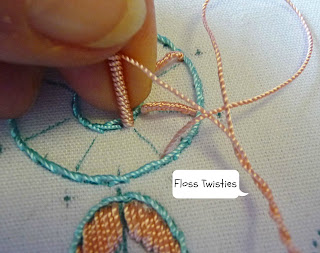A lot of us have discovered the really wonderful, helpful and educational stitches and projects shared by Mary Corbet of NeedlenThread. You can click on the link here, or on the left side of this page where I've listed "Blogs We Like".
Today Mary shares the Criss-Cross Satin Stitch that I wrote about in my book, Take A Stitch, and have used on numerous designs. It's my favorite circular stitch -- and you all know that you need to always outline any circle first with stem, outline or back stitch first for a "perfect" finished shape.
This website offers a circular version of the Rhodes Stitch, too. I believe the Rhodes Stitch is often used in needlepoint. You'll find more information and inspiration here.
If you have a chance, try the Criss-Cross Satin Stitch using EdMar's 100% rayon floss weight Cire.
Leaves. A while back, I wrote on this blog about another way to stitch holly leaves with the beautiful dimensional center vein. You can see the tutorial here.
I call this technique the Ridged Blanket Stitch, but it's actually a Ridged "Buttonhole" Stitch because stitches are very close together.
In my most recent book, "An Artist's Garden" by Rosalie Wakefield (picture/blatant advertising ahead) . . .
...in which I have LOTS of "Little" designs - stitched mostly in lighter-weight floss such as Iris and Glory, I've included a small "Holly" pattern and I'd like to share it here if you want to stitch it for a holiday whatever.
The pattern is approximately 2" tall, stitched with Iris 170 (green), and Glory 152 (Christmas red) and Glory 206 (Black). If you like the heavier-weight Cire, just enlarge the pattern:
1. Stitch the leaves with Ridged Blanket/Buttonhole Stitch.
Read the link above, which explains that you'll stitch across the entire leaf, but lift the stitch so the top "bar" of the stitch slides to the center vein. Keep stitches very close together.
2. The red berries are stitched with Criss-Cross Satin Stitch.
3. With black Glory weight, add a 2-wrap French knot to each berry -- there's a perfect spot for this knot where the satin stitching ends.
You can stitch this little design onto a holiday print cotton, cut it out and add other holiday trims, ribbons, charms, and make a pretty little greeting card. Stampers can enjoy unlimited creativity in making little cards or gift tags with these designs. (I have a sample photo on my previous post about the Li'l Christmas Tree.)
By the way, I think I mentioned earlier that the Ridged Blanket Stitch (space between stitches) worked with our textured Boucle weight floss in green makes beautiful ferns. TIP: Use the #15 milliners needle when working with Boucle.
This version is stitched with Iris:
(The little "bugs" are the ones you find in the garden that roll into a circle like little "bowling balls" - my name for them. They are made with double cast-on stitches. If you stitch them with red floss, you can add little black French knots and call them "ladybugs". We are nothing here if not flexible!)
Today Mary shares the Criss-Cross Satin Stitch that I wrote about in my book, Take A Stitch, and have used on numerous designs. It's my favorite circular stitch -- and you all know that you need to always outline any circle first with stem, outline or back stitch first for a "perfect" finished shape.
This website offers a circular version of the Rhodes Stitch, too. I believe the Rhodes Stitch is often used in needlepoint. You'll find more information and inspiration here.
If you have a chance, try the Criss-Cross Satin Stitch using EdMar's 100% rayon floss weight Cire.
Leaves. A while back, I wrote on this blog about another way to stitch holly leaves with the beautiful dimensional center vein. You can see the tutorial here.
I call this technique the Ridged Blanket Stitch, but it's actually a Ridged "Buttonhole" Stitch because stitches are very close together.
In my most recent book, "An Artist's Garden" by Rosalie Wakefield (picture/blatant advertising ahead) . . .
...in which I have LOTS of "Little" designs - stitched mostly in lighter-weight floss such as Iris and Glory, I've included a small "Holly" pattern and I'd like to share it here if you want to stitch it for a holiday whatever.
The pattern is approximately 2" tall, stitched with Iris 170 (green), and Glory 152 (Christmas red) and Glory 206 (Black). If you like the heavier-weight Cire, just enlarge the pattern:
1. Stitch the leaves with Ridged Blanket/Buttonhole Stitch.
Read the link above, which explains that you'll stitch across the entire leaf, but lift the stitch so the top "bar" of the stitch slides to the center vein. Keep stitches very close together.
2. The red berries are stitched with Criss-Cross Satin Stitch.
3. With black Glory weight, add a 2-wrap French knot to each berry -- there's a perfect spot for this knot where the satin stitching ends.
You can stitch this little design onto a holiday print cotton, cut it out and add other holiday trims, ribbons, charms, and make a pretty little greeting card. Stampers can enjoy unlimited creativity in making little cards or gift tags with these designs. (I have a sample photo on my previous post about the Li'l Christmas Tree.)
By the way, I think I mentioned earlier that the Ridged Blanket Stitch (space between stitches) worked with our textured Boucle weight floss in green makes beautiful ferns. TIP: Use the #15 milliners needle when working with Boucle.
This version is stitched with Iris:
(The little "bugs" are the ones you find in the garden that roll into a circle like little "bowling balls" - my name for them. They are made with double cast-on stitches. If you stitch them with red floss, you can add little black French knots and call them "ladybugs". We are nothing here if not flexible!)
Rosalie























































